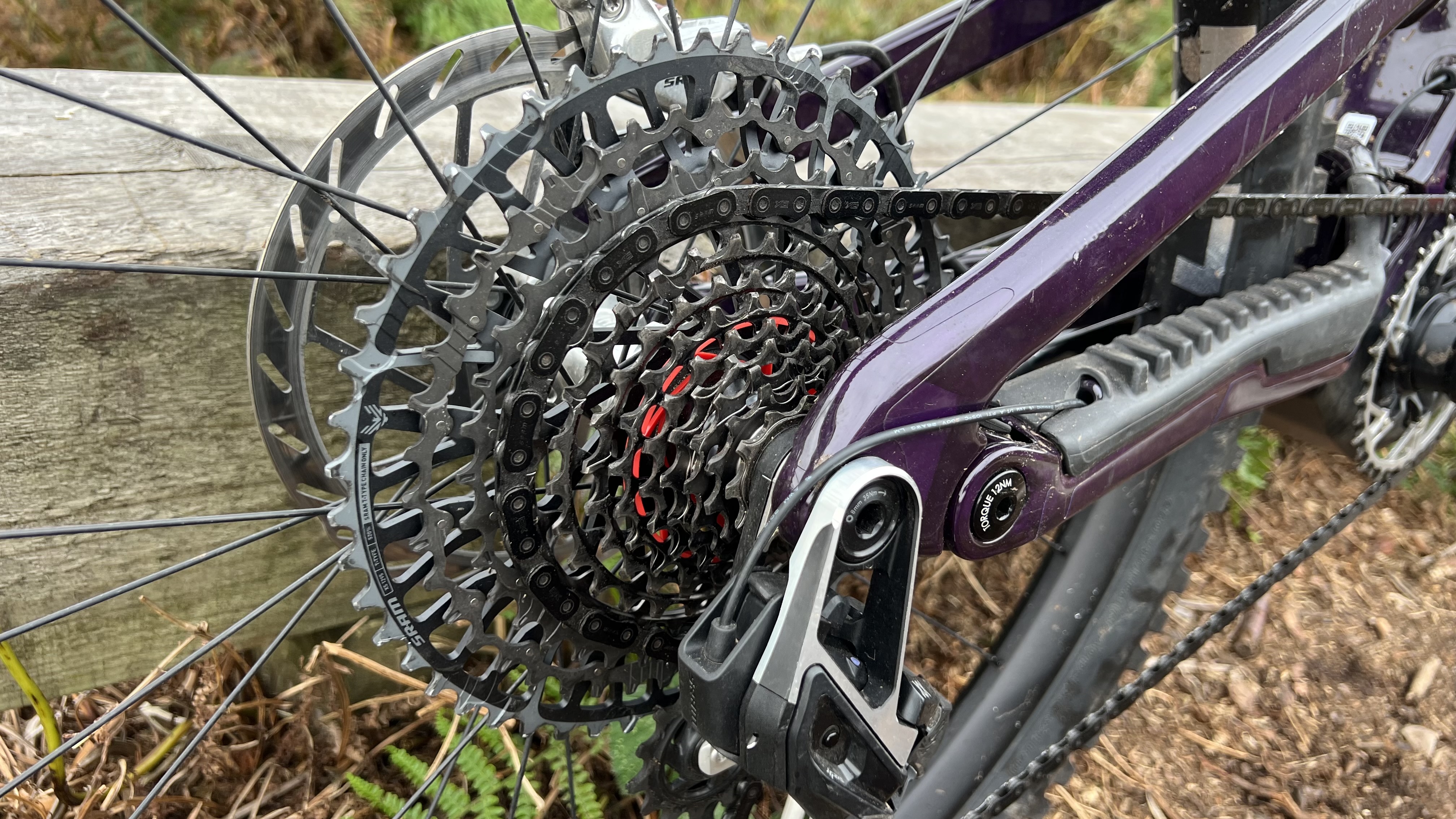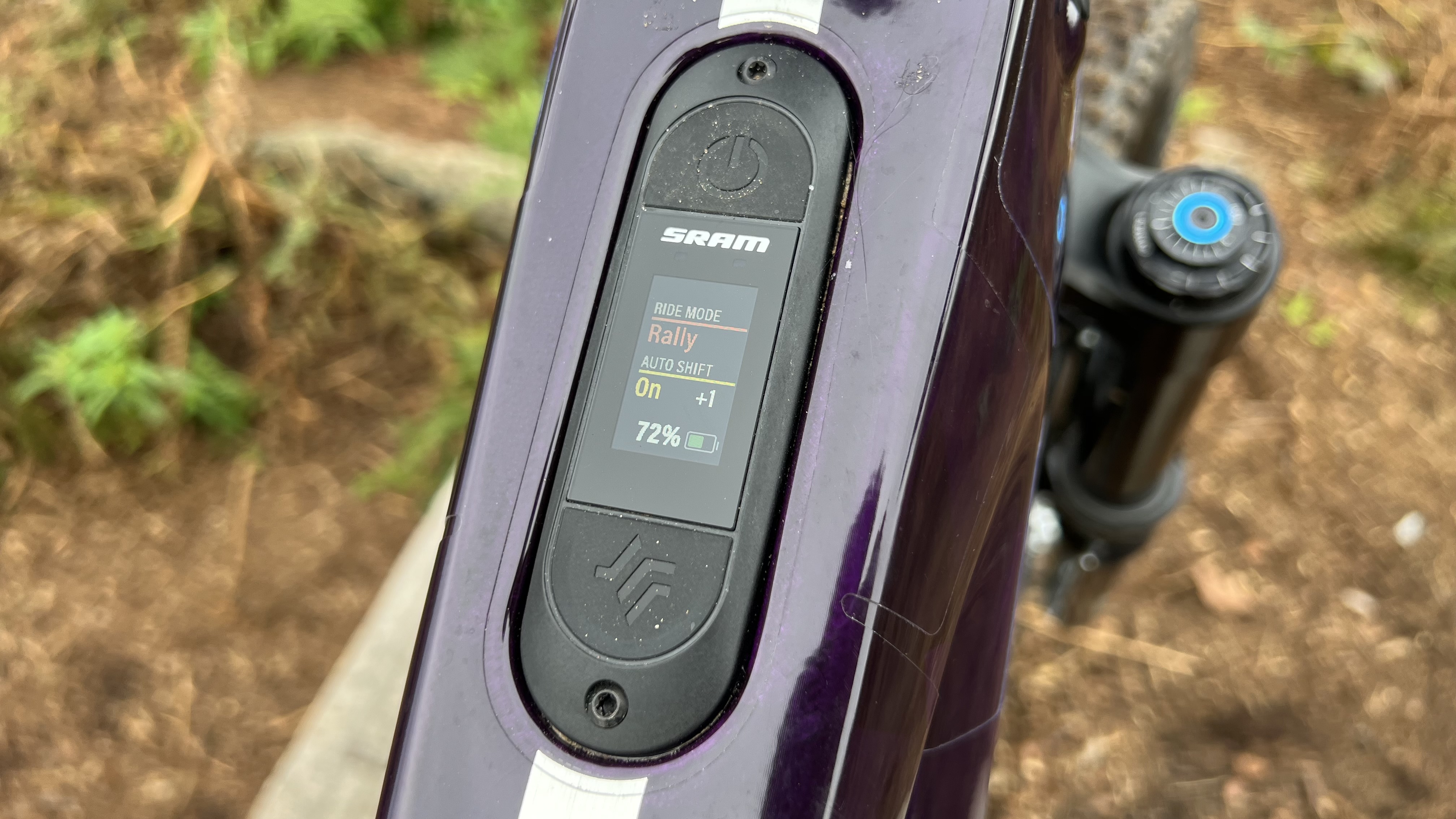Bike Perfect Verdict
On paper, Eagle Powertrain is just a very well synced e-MTB and shift system. On the trail, it's a remarkably mind freeing, fun expanding upgrade for experienced riders and potentially a complete game-changer for the newbies who make up an increasing part of the mountain bike landscape.
Pros
- +
Genuinely game-changing gear-changing
- +
Auto Shift is awesome and addictive
- +
Coast Shift is way more useful than expected
- +
Superb syncing with rest of the SRAM 'ecosystem'
- +
Brose motor is proven and powerful
Cons
- -
Only limited bike options at launch
- -
No USB-C charger port
- -
Pricing is unconfirmed
Why trust BikePerfect
Let’s get this clear right away. SRAM’s new Powertrain Eagle system is the most seismic change in e-MTB – and therefore MTB overall given the sales numbers – in years. Riding it immediately and totally flips the focus from torque and watt hours to how you interact (or not) with the transmission and terrain as a whole. So how have SRAM done it and is taking shifting stress away to free your mind for the fun stuff the most powerful riding drug anyone has pedaled since we added power to MTBs?

The bit that doesn’t matter as much as you think anymore
SRAM’s new motor has been a rumour for a few years and a spy shot reality at e-MTB enduros all year. That’s inevitably sparked a lot of discussion and speculation about battery and motor performance, manufacturer and display specifics. If you must know, SRAM are basically using an evolved version of the Brose motor Specialized use in their Levo and Kenevo e-MTBs. Peak power in Rally mode is 680W with 90Nm of torque, noise levels are average, pick up and support levels are intuitive from trudge to spin and it’s really well sealed from water. The 2.9kg weight is comparable to Bosch CX but slightly heavier than Shimano EP801.
Powering the motor there are 720Wh (4.1kg) or 630Wh (3.1kg) slimline high capacity, slide in or clip on battery options, with 250Wh range extenders available from November too. Any servicing / warranty work can he handled through any SRAM dealer. So basically all bike shops.

Grand Shift Auto
Auto shifting gears are nothing new either. I’m pretty sure there’s a Shimano patent for them for shopping bikes from the '70s (or maybe even the '60s) and they’ve appeared regularly since then, including the system Shimano revealed recently. The difference here is that while the new Shimano has had mixed and largely lukewarm reviews, Powertrain works very intuitively with a very polished performance. Plus you’ll be able to buy Nukeproof Megawatt bikes with it next week and models from Transition, Propain and GasGas soon after.
What’s interesting is the seeming simplicity of the system. Currently, Auto Shifts are only triggered by cadence (how fast you’re pedaling) while Coast Shifts are triggered by changes in wheel speed. This is monitored by six magnets on the rear hub disc brake mount and engages the motor to spin the chainring and chainring to shift the gears even if your feet are still. To avoid any possible confusion, Coast shifting doesn’t rely on proximity to the seaside either, it’s coasting in the sense of not pedaling.
In terms of shifting mechanics, the system gets a very pretty new chainring design with XX carbon (tested) XO and GX spec crank options. These are synced with a T-Type Eagle Transmission including flat top chain, 10-52 tooth cassette and UDH clamping T-Type rear mech in whatever flavor of spec your wallet can allow. The only difference is that the AXS cartridge battery is replaced with a clip-in connector with a direct wired link to the main cell.
While the motor itself is fully shrouded from view (and therefore filth/spray etc), the Brose motor provenance is given away by the fact that the ‘Bridge’ TCU display on the top tube is essentially identical to the ‘Mission Control’ unit on Specialized’s Levo/Levo SL/Kenevo/Kenevo SL bikes. However clean the display is though, the neatest part of the system is the complete lack of obvious e-MTB hardware on the bars. Instead you get specific Eagle Powertrain versions of SRAM’s latest two-button Pod controllers. The right hand Pod lets you engage or disengage Auto Shift and works as a standard AXS shifter if needed. Holding the lower button accesses cadence tuning mode at which point you select from one of the seven different settings (three minus, Mid and three plus) by using the shift paddles as plus or minus buttons. The left Pod covers AXS dropper post actuation, Rally/Range power mode changes and Push (walk) mode. Both are highly adjustable for position with two sizes of click on rubber button covers available. The only downer is that there’s no USB-C charge port on the frame for GPS or other peripherals, although you can connect front and rear lights with an internal wiring harness.

Shifting perspectives
It’s telling that while all the pre-gossip about Powertrain centred on motor and battery specs, SRAM are deliberately downplaying that aspect in the PR info. Instead it’s all about "Going for the better ride’ with ‘power applied properly’ for ‘the most natural ride experience ever’", and my personal favorite "Go for feeling super. And human."
Behind all the cute language there’s clearly been a huge amount of very high level ride assessment, rider profiling of everyone from beginners to Black Box enduro athletes – Yannick Pontal won the 2022 EWS-E championship on Powertrain prototypes. The has fed into some extremely smart software, firmware and algorithm design to sync the proven motor with the next level under power shifting of Eagle T-Type.
The result is that despite deliberately picking the worst possible trails (if you know Stainburn in Yorkshire you know what I’m on about) for sudden, almost completely flow free changes in speed, steepness and power requirements Powertrain blew me away. Within a few minutes I’d worked out what mode worked best for me (+1 95 percent of the time, +2 for really steep, tech sections where I didn’t want an accidental upshift if I charged a crux move) and from then on I just surrendered gear control to SRAM.
I’m not going to claim the system is perfect, but even with over 40 years experience of pre-judging gear selection, it was at least as good as I am. It’s definitely better than me in the Coast mode where it spools up the chainset to shift into the appropriate gear for your speed without your feet moving. As someone with hard wired reflexes so ancient that I’ve been confused into thinking I was on Gripshift when using DMR Deathgrip grips with their fatter inner section, was how quickly interaction became intuitive. You can still use the Pod controllers as over-ride shifters, but within a couple of runs up and down the hill I was just slightly adjusting my pedal speed to control the Auto Shift instead.
From there on it was just a case of marvellng at just how good the rear mech performed as I kept charging full power. The Auto Shift did it’s thing so seamlessly, that apart from cadence changes, only an occasional gear growl told me something was happening. One unexpected side effect was that chasing the next upshift rapidly became the best game ever. Perhaps it’s more of a reflection on me and is something that will fade with familiarity, but charging up twisting tech singletrack at downhill speeds while laughing like a maniac because the only control you’re touching is the the rear brake is an absolute blast.
Even with a long history of being evangelical about riding single speed bikes, it’s also remarkable how much fun floods into the parts of your mind normally filled with ratio selection calculations. And that’s speaking as someone who gets a lot of pleasure from a perfectly timed, seamless shift, not as someone without the experience to get gears right in a situation where they’re already struggling with line choice, traction assessment, body position and power application.

First ride verdict
It took me less than an hour for me to say I didn’t want to ride an e-MTB without Eagle Powertrain ever again and I probably would have said it earlier if I wasn’t laughing so much. I even made Al from SRAM explain tech specifics while we were riding because talking while we were stopped seemed too much like a waste of possible play time. And if you think riding with the UK's SRAM man would influence my opinion, you clearly don’t understand that for every sweet bit of schwag and fish and chip lunch I’ve greedily taken over the years, I’ve regularly repaid them by being the media equivalent of the kind of saddle sore that took Tom Pidcock out of the Tour of Britain.
I even went into this test with a highly unprofessional, preloaded attitude that adding Auto Shift was a step too far in removing riders from the ride itself. That included telling anyone who would listen beforehand that I thought the system sounded like the kind of arse wipe over-intervention that I’d definitely be swiping left on.
Yeah well, it took literally one retune of the cadence calibration (done in under five seconds while riding) for me to leave my ‘over cynical for the sake of credibility’ preconceptions behind and get fully on board the runaway train that Powertrain represents.
We’re only looking at the tip of the iceberg in terms of what extra information and refinement SRAM can add to the system from other sensors, as soon as they flush the appropriate firmware through, too. While there might be specifics I haven’t reckoned on, I can’t see a reason they can’t port the system across to other motors within e-MTB or other categories like urban or cargo bikes where Auto Shift is potentially even more welcome. Maybe we’ll even see an Auto Shift system for meat powered bikes using a simple power/cadence meter like the ‘torque Tampon’ upgrades available for SRAM’s gravel groups?
Even in it’s relatively simple roll out format though, Eagle Powertrain is a remarkably mind freeing, fun expanding upgrade for experienced riders and potentially a complete game changer for the newbies who make up a massive part of the e-MTB landscape.
Industry impact
Any issues resulting from adding another extinction horizon to the MTB tech world (particularly so soon after T-Type made a lot of existing overstock obsolete overnight) remains to be seen. However, if other people have a similar experience to me demo riding Powertrain, then I reckon 'auto-shift' will also apply to anyone getting stock of new SRAM equipped e-MTBs.
Tech specs: SRAM Eagle Powertrain
- Motor torque: 90Nm
- Peak power: 680W
- Power modes: Range and Rally
- Drive unit weight: 2.9kg
- 630Wh battery weight: 3.1kg
- 720 battery weight: 4.1kg

Guy Kesteven has been working on Bike Perfect since its launch in 2019. He started writing and testing for bike mags in 1996. Since then he’s written several million words about several thousand test bikes and a ridiculous amount of riding gear. He’s also penned a handful of bike-related books and he reviews MTBs over on YouTube.
Current rides: Cervelo ZFS-5, Specialized Chisel, custom Nicolai enduro tandem, Landescape/Swallow custom gravel tandem
Height: 180cm
Weight: 69kg

